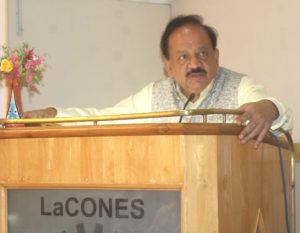
Union Minister for Environment, Forest & Climate Change Minister Dr Harsh Vardhan on August 12, 2018 dedicated India’s only facility for conservation of endangered species.
- The Laboratory for the Conservation of Endangered Species (LaCONES), a dedicated facility of CSIR’s Centre for Cellular and Molecular Biology (CCMB) in Hyderabad uses modern biotechnologies for conservation of endangered wildlife.
- Here off-springs of blue rock pigeon, spotted deer and blackbuck are produced, which were on the verge of extinction, through artificial insemination of cryopreserved sperm.
- CCMB scientists in collaboration with Nehru Zoological Park, Hyderabad have now rescued
- As per the Union Minister, the success story of Indian Mouse Deer presents an example of collaborative effort of different agencies – CSIR-CCMB, Central Zoo Authority and Telangana State Forest Department in working towards a national cause. This is also an example of converging approaches – molecular biology, genomics, reproductive and behavior biology shaking hands with planned conservation breeding and ecology & environment to rescue an almost extinct species back to its native space.
- Despite being one of the most biodiverse countries in the world, nearly 14% of all species in India face serious threat of extinction. It is therefore, important to carry out conservation breeding and assisted reproductive strategies for conservation and management of threatened species. Long-term storage of gametes, primary cells and tissues collected from threatened species could be an important step in establishing genetic resource for reproductive technologies in conservation breeding programmes.
About CCMB-LaCONES
- CCMB-LaCONES is the only laboratory in India that has developed methods for collection and cryopreservation of semen and oocytes from wildlife and successfully reproducing endangered blackbuck, spotted deer and Nicobar pigeons.
- Through this work, it has established Genetic Resource Bank for Indian wildlife.
- So far, genetic resources from 23 species of Indian wild animals have been collected and preserved.
- This facility would increase the collection of genetic resources from wildlife through collaboration with zoos in India.
- It would also facilitate exchange of genetic material between the Indian zoos for maintaining genetic diversity and conservation management made accessible to scientists and wildlife managers for implementing conservation programs.


